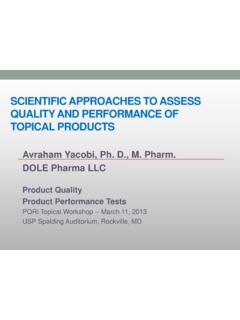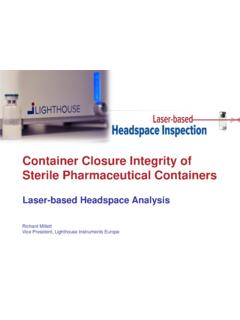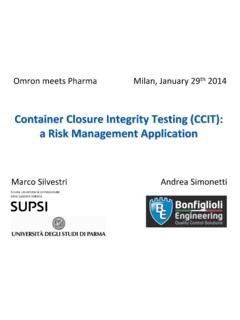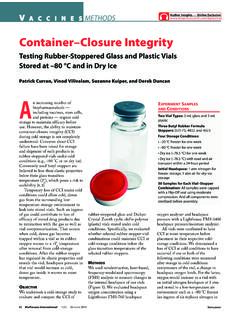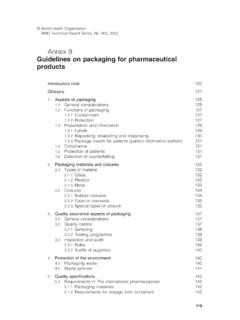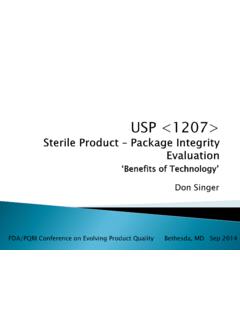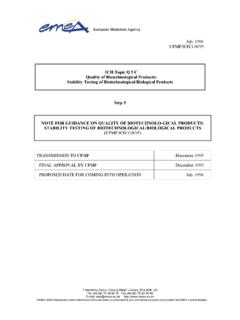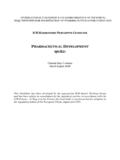Transcription of Container Closure Integrity of the AT-Closed Vial Stored ...
1 Container Closure Integrity of the AT-Closed Vial Stored at Cryogenic Temperatures Proven Using Non-Destructive Headspace Analysis. Introduction Several drug products, such as live viral vaccines or products containing active cells, generally require storage at dry ice or cryogenic temperatures. Storage at such low temperatures can potentially lead to loss of Container Integrity during storage. One problem that can arise for pharmaceutical stoppered vials is that commonly used butyl stoppers lose their elastic properties at these low temperatures since their glass transition temperature (Tg) is typically in the range of -55 c / -70 c. Traditional Container Closure Integrity testing are not relevant to detect leaks at low temperatures as they are to be performed at room temperature, when the Container temperature is back above Tg of the stopper, which can therefore regain its elastic properties and reseal the sample.
2 Effective detection of a leak during storage is possible by non-destructive test of headspace analysis. As a matter of fact, a leak during storage at low temperature implies nitrogen ingress in the headspace which can then be detected by measuring a change in headspace oxygen level and/or an overpressure in the vial. Such non-destructive headspace analysis is possible thanks to Frequency Modulation Spectroscopy (FMS), such as the method developed by Lighthouse. Method and Materials For this study, 220 samples were tested. AT-Closed Vials (1ml and 6ml, 50 each) and glass vials (13mm and 20mm, 50 each), all filled with of water and with initial atmospheric pressure. 13mm glass vials were crimped using a semi-automated device set at a force of 270 Newton while the 20mm were hand-crimped. All the glass vials were twist tested after crimping.
3 Positive controls (five) were prepared for each of all four configurations. Those positive controls were created by puncturing the stopper with a single capillary (inner diameter of 10 m). Vials were Stored 11 days in the gas phase of the liquid nitrogen at a temperature of -165 C. Headspace oxygen and pressure measurements were performed using respectively calibrated FMS-760 and FMS-1400 analyzers from Lighthouse. Results Change in headspace oxygen levels: a leaking vial having an initial air headspace at 1 atm and Stored in nitrogen gas phase would reveal oxygen depletion as the nitrogen gas progressively replaces the air. The below graphs show the oxygen levels before (in blue) and after storage (in red) in the different vial types. Positive control vials are plotted far right in the graphs. Oxygen measurement in 1ml AT-Closed Vials show no modification.
4 Ten samples of the 13mm glass vial reveal oxygen depletion. Comparable results are observed in 6ml AT-Closed Vials . In the 20mm glass vial, all samples show decreased levels of in the vial: cold gas trapped in the headspace after a leak during storage is expanding at room temperature, leading to overpressure. The results are fully in line with headspace oxygen levels for the different vial types. Conclusion The study performed by Lighthouse, using a method known as Frequency Modulation Spectroscopy, revealed an uncompromised Integrity of the AT-Closed Vial after storage in the gas phase of liquid nitrogen (-165 C). None of the samples showed modified oxygen levels in their headspace, or increased pressure, meaning they remained completely tight during cold storage. In comparison, 20% to 100% of glass vials closed using butyl stopper and crimped (manually or at a monitored set force) showed signs of leakage during storage in the same conditions.
5 2014 Aseptic Technologies Container Closure Integrity Using Headspace Analysis V2



